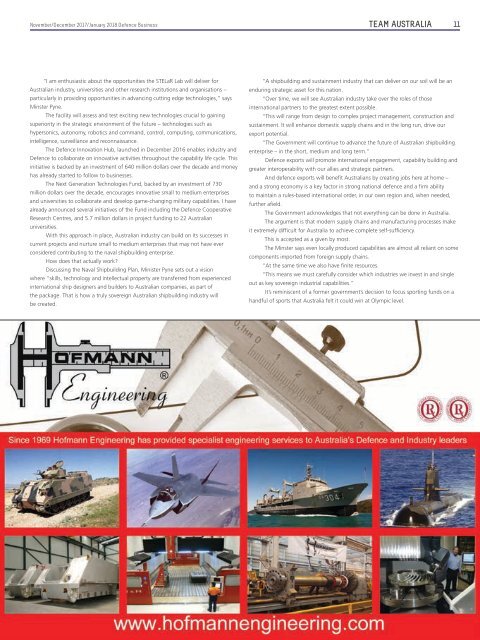Defence Business_Issue 41 (Nov 17 – Jan 18)_DTC_Web
Create successful ePaper yourself
Turn your PDF publications into a flip-book with our unique Google optimized e-Paper software.
<strong>Nov</strong>ember/December 20<strong>17</strong>/<strong>Jan</strong>uary 20<strong>18</strong> <strong>Defence</strong> <strong>Business</strong><br />
TEAM AUSTRALIA<br />
11<br />
“I am enthusiastic about the opportunities the STELaR Lab will deliver for<br />
Australian industry, universities and other research institutions and organisations <strong>–</strong><br />
particularly in providing opportunities in advancing cutting edge technologies,” says<br />
Minster Pyne.<br />
The facility will assess and test exciting new technologies crucial to gaining<br />
superiority in the strategic environment of the future <strong>–</strong> technologies such as<br />
hypersonics, autonomy, robotics and command, control, computing, communications,<br />
intelligence, surveillance and reconnaissance.<br />
The <strong>Defence</strong> Innovation Hub, launched in December 2016 enables industry and<br />
<strong>Defence</strong> to collaborate on innovative activities throughout the capability life cycle. This<br />
initiative is backed by an investment of 640 million dollars over the decade and money<br />
has already started to follow to businesses.<br />
The Next Generation Technologies Fund, backed by an investment of 730<br />
million dollars over the decade, encourages innovative small to medium enterprises<br />
and universities to collaborate and develop game-changing military capabilities. I have<br />
already announced several initiatives of the Fund including the <strong>Defence</strong> Cooperative<br />
Research Centres, and 5.7 million dollars in project funding to 22 Australian<br />
universities.<br />
With this approach in place, Australian industry can build on its successes in<br />
current projects and nurture small to medium enterprises that may not have ever<br />
considered contributing to the naval shipbuilding enterprise.<br />
How does that actually work?<br />
Discussing the Naval Shipbuilding Plan, Minister Pyne sets out a vision<br />
where “skills, technology and intellectual property are transferred from experienced<br />
international ship designers and builders to Australian companies, as part of<br />
the package. That is how a truly sovereign Australian shipbuilding industry will<br />
be created.<br />
“A shipbuilding and sustainment industry that can deliver on our soil will be an<br />
enduring strategic asset for this nation.<br />
“Over time, we will see Australian industry take over the roles of those<br />
international partners to the greatest extent possible.<br />
“This will range from design to complex project management, construction and<br />
sustainment. It will enhance domestic supply chains and in the long run, drive our<br />
export potential.<br />
“The Government will continue to advance the future of Australian shipbuilding<br />
enterprise <strong>–</strong> in the short, medium and long term.”<br />
<strong>Defence</strong> exports will promote international engagement, capability building and<br />
greater interoperability with our allies and strategic partners.<br />
And defence exports will benefit Australians by creating jobs here at home <strong>–</strong><br />
and a strong economy is a key factor in strong national defence and a firm ability<br />
to maintain a rules-based international order, in our own region and, when needed,<br />
further afield.<br />
The Government acknowledges that not everything can be done in Australia.<br />
The argument is that modern supply chains and manufacturing processes make<br />
it extremely difficult for Australia to achieve complete self-sufficiency.<br />
This is accepted as a given by most.<br />
The Minster says even locally produced capabilities are almost all reliant on some<br />
components imported from foreign supply chains.<br />
“At the same time we also have finite resources.<br />
“This means we must carefully consider which industries we invest in and single<br />
out as key sovereign industrial capabilities.”<br />
It’s reminiscent of a former government’s decision to focus sporting funds on a<br />
handful of sports that Australia felt it could win at Olympic level.


















